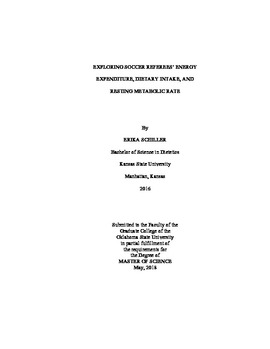| dc.contributor.advisor | Wollenberg, Gena Suela | |
| dc.contributor.author | Schiller, Erika | |
| dc.date.accessioned | 2019-03-25T20:05:25Z | |
| dc.date.available | 2019-03-25T20:05:25Z | |
| dc.date.issued | 2018-05-01 | |
| dc.identifier.uri | https://hdl.handle.net/11244/317703 | |
| dc.description.abstract | Professional soccer referees must keep up with the physical demands of a soccer match while staying cognitively focused on the game. To sustain high muscle and brain function, a well-rounded and adequate diet is necessary. The main purpose of this study was to determine if male professional soccer referees are fueling their bodies to sustain energy throughout a soccer match and reaching daily-recommended energy needs. The other purposes were to determine how a new metabolic device, Breezing®, compares to commonly used metabolic equations as well as to measure the adequacy of the referees' macronutrient intake and to determine the average distance covered in a match by a center referee. | |
| dc.description.abstract | Ten professional soccer referees (ages 27-50) from the Professional Referee Organization (PRO) completed 3-day dietary records. Match-day and average energy intake was compared to match energy expenditure, obtained from GPS watches. Average 3-day and match-day energy intakes were compared to recommended energy needs, calculated using Breezing® and three metabolic equations. These methods to determine estimated energy needs were analyzed to evaluate how the values compared between equations. Average macronutrient intakes were compared to recommended values for this population. Lastly, the average distance covered and energy expended per match by the center soccer referee was recorded. | |
| dc.description.abstract | Match day energy intake and average energy intake did not significantly differ from match energy expenditure (p = 0.459, p = 0.936, respectively). Estimated total energy expenditure was significantly higher than average reported energy intake (p <0.001). Breezing® results were most closely related to the Mifflin-St. Jeor (p=0.286) and Harris-Benedict (p=0.045) equations. Carbohydrate intake was significantly lower than the recommendation (p < 0.001), while protein and fat intakes were adequate. The average distance travelled and average energy expended was 9.77 ± 0.91 km (6.07 ± 0.57 miles) and 1,680 ± 341 kcal, respectively. | |
| dc.description.abstract | Professional soccer referees' reported energy and carbohydrate intake did not cover the costs of the high demands of refereeing. The Breezing® device, along with the Harris-Benedict and Mifflin St. Jeor equations show similar results in estimating resting metabolic rate in this population. Future studies on professional soccer referees should implement nutrition education to increase energy and carbohydrate consumption, maintain fat and protein intake, and reinforce correct reporting on dietary records. | |
| dc.format | application/pdf | |
| dc.language | en_US | |
| dc.rights | Copyright is held by the author who has granted the Oklahoma State University Library the non-exclusive right to share this material in its institutional repository. Contact Digital Library Services at lib-dls@okstate.edu or 405-744-9161 for the permission policy on the use, reproduction or distribution of this material. | |
| dc.title | Exploring Professional Soccer Referees' Energy Expenditure, Dietary Intake, and Resting Metabolic Rate | |
| dc.contributor.committeeMember | Gates, Gail | |
| dc.contributor.committeeMember | Lucas, Edralin A. | |
| osu.filename | Schiller_okstate_0664M_15589.pdf | |
| osu.accesstype | Open Access | |
| dc.description.department | Nutritional Sciences | |
| dc.type.genre | Thesis | |
| dc.type.material | text | |
